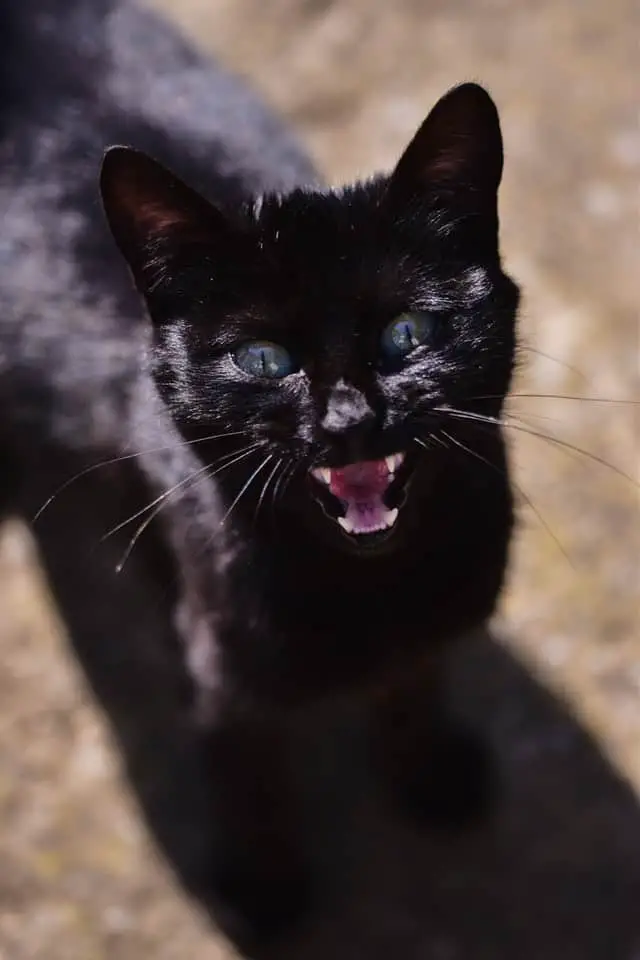
Domestic cats, at times, also become aggressive towards their own family. Why does a cat attack its owner and when can it be dangerous?
Certainly, cats are among the most widespread and popular pets in the world. They are loved by many fans, we often see them as nice life companions also thanks to the huge following they have on the internet, but we must never forget that even if we are talking about a ball of fur, it is equipped with claws and teeth as sharp as blades. In addition, a scratch or a bite from this animal can become seriously infected and transmit diseases in humans. Often all this is underestimated, but aggressive cat behavior can have very negative effects. When should we worry, and especially how dangerous can cats really be?
Human killer cats? Just a myth
If we wanted to look for some statistics on human cat victims, we would find nothing – as we would if we look for statistics of humans killed by dogs or exotic animals, actually. As aggressive as a cat can be, and as much as there are certainly dangers in the event of an attack, cats are too small physically to kill an adult human.
They could, theoretically, overwhelm a human baby, but there is no recorded case in reality, despite the various urban legends of malefic cats choking infants. They are scary stories like those of witches with black cats, nothing more.
Sure, cats are predators of small animals (mice, birds, etc.) and are certainly territorial and competitive, but they don’t attack children in a really dangerous way, at least not in a deliberately lethal way. A cat can have many reasons for attacking an adult or child, but it is usually a defense to a behavior (voluntary or not) that he sees as a threat. In practice, it usually attacks if provoked.
Cats are always dangerous
We must first put this discourse in perspective, before talking about the dangers of cats. Of course, these animals are now domesticated, but not when it comes to the propensity for aggression. However, a pet is capable of attacking when needed, it is not a behavior that is removed during the domestication process.
We must therefore not underestimate the possibility that a cat – even if considered a pet – may, if necessary, have the instinct that is commonly associated with wild animals. The behavior of animals is in fact derived from the environment in which they live and how they are raised: if a cat is not socialized correctly towards humans, it will be “wild” enough to resemble its ancestors. Likewise, a feral cat that is properly bred and tamed will be similar to a domestic cat.
A properly socialized pet will usually have no reason to severely attack a human unless provoked. But obviously we are talking about living beings, so a particular episode or a particularly strong situation could happen for which an animal will be very stressed and respond in a negative way.
When a cat attacks its owner, it could also be unprecedented. How often do we hear “My cat has never done this before” after an immediate bite or scratch? Unfortunately, at any moment and in any situation the cat could have a negative reaction, even for the first time.
Domestication of a wild feline is not related to not attacking humans. We cannot compare the number of humans attacked by a tiger or a jaguar (felines usually considered dangerous), who have great physical strength, with that of a small cat. If a cat is the same size (and muscle) as one of its scarier “cousins”, it will likely have the same kind of danger.
Many big cats, however tame, may still attack their owners. Except that, unlike cats, a single truly violent attack from these animals could be lethal to their human.
Why Cats Attack Humans
We have all seen some videos on the internet of cats attacking their owners in a violent way, often laughing at us and amazed at what happened. But such incidents are not that rare. Pets can be a threat if we underestimate them.
And above all, it can be dangerous if we don’t know how to read the signs of stress that is so severe that it exasperates the cat. So let’s learn what are the causes of such attacks and what are the signs to learn to read, to intervene immediately and avoid such problems with our beloved pets.
- Fear: undoubtedly, one of the main reasons for aggression by cats.
- Maternal aggression: A mother cat doesn’t feel safe around her kittens.
- Cuddle-Induced Aggression: If our cuddling, stroking, or manipulating the cat causes too much stimulation or even a feeling of discomfort, our pet may bite us. Some signs to watch out for: pinched tail, meow, change in body position, skin twitching.
- Territorial Aggression: All cats are subject to this type of aggression. It can happen to other cats, other animals or humans when the cat feels that its territory is threatened.
- Redirected aggression: something annoying for the cat is not reachable for him / her, so he decides to “let off steam” on his master. This type of aggression seems to happen apparently for no real reason, because we don’t notice the source from which it arises.
- Pain-induced aggression: when a point on the body in the cat is touched that causes pain to the animal.
- Unprovoked aggression: Apparently, the cat attacks its owner for no reason. Rather rare, not easy to diagnose (often confused with redirected aggression).
The signs to learn to understand are varied, and all pet owners should know them or they will not be able to understand what is bothering their furry companion. The most common signs of stress in domestic cats are divided between defensive and aggressive.
The defensive, or even submissive, stance is indicated by signs such as dilated pupils, bristly fur on the back, curved and downward tail, open mouth (usually accompanied by spitting and puffing), flat, backward-pointing ears. Furthermore, the cat tends to flatten itself on the ground, and when it looks at its “opponent” it does not do it directly but sideways.
The position of offensive aggression, very dangerous and to be kept under control, indicates a cat immediately ready to attack. Under no circumstances should you try to reason, calm or comfort a cat in this position. The most common signs are: looking straight at its target, walking straight at it and facing it confidently, the tail is straight down (not curved), the ears are straight with the back slightly rotated forward, straight hair. It is usually accompanied by growls.
As it is easy to understand, the main differences are in the ears (facing forward or backwards), in advancing (advancing confidently, or almost seems to retreat), and in the sounds that the cat emits. However, if the cat is affected by anger, as in the case of strays, the behavior can be irrational and therefore it is more difficult to describe the signs with precision.
The risks of cat bite

We must not underestimate a cat that attacks its owner, both from a psychological and physical point of view: in fact, cat bites have a strong tendency to be infected, even more than those of dogs. The reason is related to the shape of the teeth, which being very sharp create deep wounds, so as to promote bacterial activity, and are also more difficult to disinfect.
In addition, unfamiliar cat bites are very risky due to rabies. Cases of humans contracting rabies are quite rare, but cats are considered the most frequently infected pets in the United States alone. In fact, if we are bitten by an unknown cat, we must immediately go to an emergency room and check the severity of the injuries.






